Want accessible Mopar muscle? Check out Dodge’s ’67–76 Dart
Back when Dodge Darts were regular sights on the road, nobody saw them as future collector cars. After all, the Dart was a budget compact first and foremost, the kind of thing your mom might commute to work in, then hand down to you on your 16th birthday. Most 1967–76 Darts had a humble Slant Six or a lethargic V-8 under their square hoods, puttering them from A to B and back to A again.
But the Dart had several sexier, sportier versions, and the plain-Jane reputation of the model is largely what made these sharper Darts so dang cool. Some of them were true sleepers—dog dish hubcaps and boring paint hiding the oversized eight underneath. Others threw off their pedestrian origins and shouted for attention—loud ’70s colors and hood scoops big enough to nap under. Either way, the fourth-generation Dart is yet another example that the combination of little car plus big engine plus low price can be a winning formula. Five decades after they left the showroom, these cars still offer a tempting value in classic American muscle, despite some recent price gains.
A Dart is born
Back in the 1950s, swoopy Jet Age concept cars with flight-inspired names were a regular sight on the American show circuit, and in 1956 Chrysler debuted a concept by Virgil Exner and Ghia called the “Dart,” followed in 1957 by the “Super Dart 400.” Technically, these were the first Darts, but Chrysler threw the first production, Dodge-branded darts at the board in 1960.
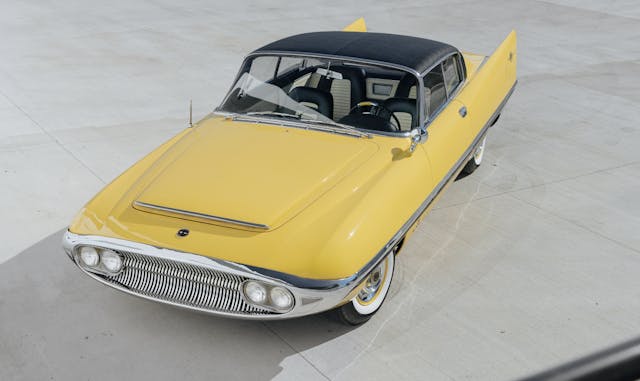
At first, market research suggested the name “Zipp” for some reason, but thankfully Dodge went with Dart for its new downsized, low-priced line. In 1963, Dodge updated its Lancer but axed that name and replaced it with Dart. That series lasted until 1966.
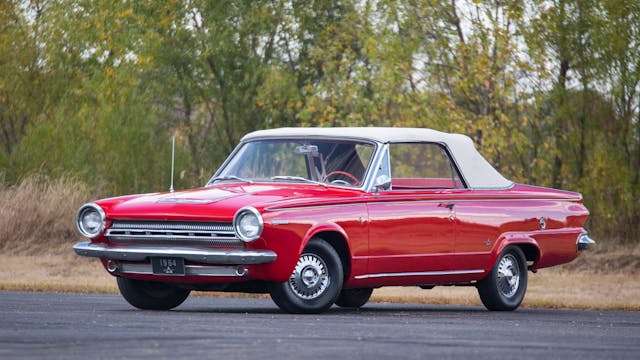
The A-body, 111-inch wheelbase 1963–66 Dart was a good-looking car. Its narrow grille flanked by huge circular headlights on the 1965–66 models are lovely features, and they bear a pleasing resemblance to the Chrysler Turbine. It was also a strong seller against stiff compact competition from the Chevy II/Nova and Ford Falcon, but for speed freaks at the dawn of the muscle car age, it was an easy car to overlook. There was only room for a 273-cubic inch V-8 under the hood—big enough for trips to work, but a little disappointing for those short squirts between stop lights.
In 1967, though, when Chrysler revamped the A-body platform (including the Plymouth Valiant and Barracuda), the Dart’s frame rails grew wider, adding room under the hood for more cubic inches. The 273 stayed on until 1969, but the options list lengthened and the Dart joined a new, smaller breed of American muscle cars. The styling, meanwhile, became more conventional with a mildly muscular three-box design. But if its lines were boring, they only added to the car’s appeal as a sleeper.
Cranking things up with the GTS
Across town, Chevrolet was doing quite well with its own compact muscle car, the Nova SS. As it turned out, plenty of buyers (especially young people) had the need for speed but couldn’t scrape together the coin for one of the bigger mainstream muscle cars. Then, as the muscle car years reached their peak and those bigger, flashier muscle cars attracted punishing insurance premiums, compact muscle cars were able to fly under the radar at lower rates for a while. So, late in the 1967 model year, Dodge introduced the Dart GT Sport (GTS) model. Little changed on the outside, but under the compact’s hood was a relatively gargantuan 383-cubic-inch V-8.
Available as a 2-door hardtop or a convertible, the GTS came back for 1968 with a 340-cubic-inch engine, conservatively rated at 275 hp, as standard. The 383 stayed on as an option. Ticking the GTS box on the order form also added Rallye suspension and a high-flow exhaust. The 383 model included beefier torsion bars, a bigger front antiroll bar, and six-leaf rear springs.
To squeeze the 383 in, the exhaust manifolds had to be modified and there was no room for an air conditioning system or a power steering pump, so parallel parking a 383-equipped GTS in the summer would be no fun at all. The 340 is considerably lighter and better balanced, plus it’s not all that much slower. It is, however, worth significantly less, and therefore a more tempting value.
But as tight a fit as the 383 engine was, a few Darts went even bigger. Hurst, the company that made shifters and occasionally dabbled in performance packages, plopped 370-horse 440-cubic-inch engines into a small number of Darts. The famous Chicago dealer Grand Spaulding Auto Sales also sold 50 of its own 440-powered Darts, called the Grand Spaulding Special (GSS).
Rare Darts with big power
In 1969, Dodge also sold a hardtop-only, M-code 440-powered Dart for drag racing, and right out of the box it could run quarter-mile times in the mid-13s. It wasn’t covered by the factory warranty, only came with a three-speed TorqueFlite automatic, and wore drum brakes on all four wheels. Going is more important than stopping in a drag race, after all. A Sure Grip differential also came standard, while 3.55 or 3.91 gear sets were available. While Dodge sold nearly 200,000 Darts of all kinds in 1969, only about 650 left the factory with the 440 engine in 1968 and ’69.

There were Hemi Darts, too, built for NHRA Super Stock drag race competition. They could hit 10s in the quarter-mile and only about 80 were built, making them one of the rarest classic Mopars. They almost never pop up for sale.
Into the Swing(er) of things
Despite its speed, the Dart GTS was a slow seller and Dodge dropped it after 1969. In its place came the Swinger 340, which included a Hurst-shifted four-speed, Rallye suspension, bumble bee stripes, and 14-inch wheels. “For the Smart Swinger…the Dart Swinger,” said Dodge. For those who weren’t of the era, Merriam-Webster defines the term in period as “a person who is lively, exciting, and fashionable,” and though “swinger” might mean something altogether different today, Dodge still saw fit to bring it back for 2023. I digress …
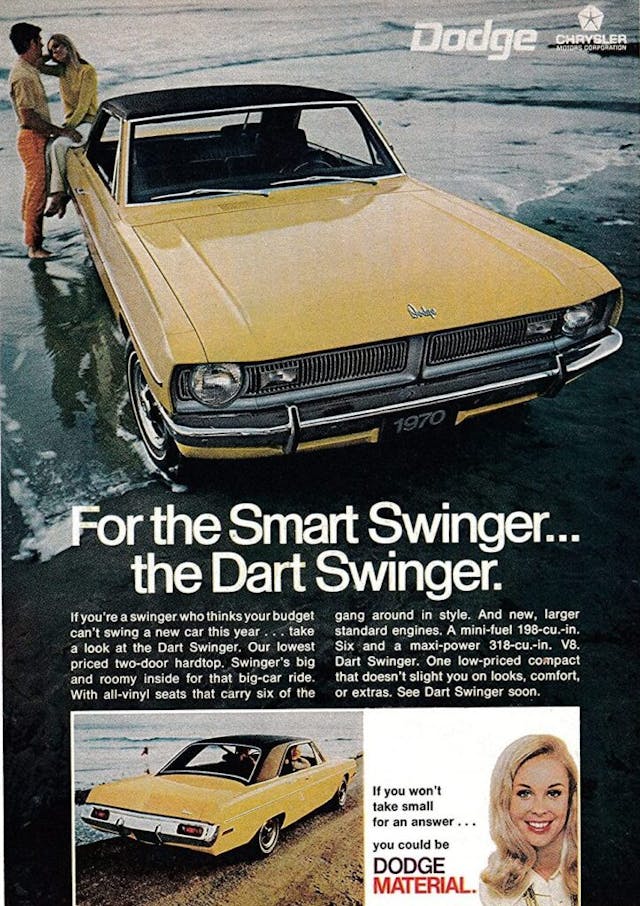
For 1970, the 383 was no longer available in the Dart, and the Swinger 340 became the sportiest available version. Even though the new Challenger got a lot of attention that year, the fast Darts remained popular and still escaped the high insurance rates hammering other muscle cars. Meanwhile, down at Plymouth, the A-body Duster was selling well and Dodge got its own version for 1971. Legend has it that it was supposed to be called the Dart Beaver, but fortunately (or unfortunately, depending on your sense of humor) Dodge went with the name “Demon” instead. The Demon 340 effectively replaced the Swinger 340 as the sportiest Dart that year, and hinted at its speedy pretensions with a dual-scoop matte black hood, hood pins, rear spoiler, and a cute little devil badge on the tail.
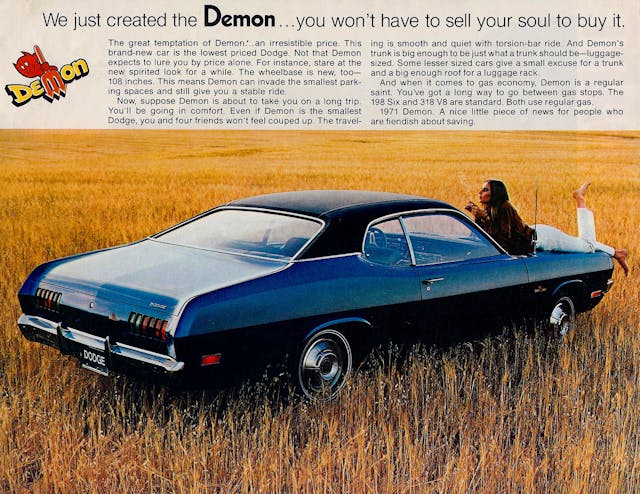
Playing up the Dart’s value for money, one ad called it a “nice little piece of news for people who are fiendish about saving” and boasted “when it comes to gas economy, Demon is a regular saint.” For 1972, horsepower was down in the Demon 340, while the devil badge vanished and the hood scoop was revised.
The Dart loses momentum
As the ’70s wore on, the Dart’s story starts to look familiar to any casual student of muscle car history. Tighter emissions rules stripped away performance and high insurance rates made ownership harder, so Mopar muscle dwindled each year. For 1973, Dodge exorcised the Demon and gave its Dart the more church-friendly name of “340 Sport.” Rated at 240 net hp, the Dart 340 Sport was the hottest in the lineup for 1973, while the Swinger lost some of its virility and made do with a 150-hp 318-cubic-inch engine. For 1974, there was a little more displacement with the 360 Sport, rated at 245 hp. But even though the high-horsepower days were in the rearview mirror, Chrysler was the best in the business at getting people to turn their heads with bright colors and loud graphics. The 1974–75 Dart “Hang Ten,” named after the surfwear company, spiced things up with Eggshell White paint, special stripes on the hood, and pinstripes down the body sides ending in graphics of a surfer catching a wave on the tail. On the inside, there were fold-down rear seats with room for a surfboard, bright multi-colored bucket seats, and orange shag carpeting. I don’t know how it could get more ’70s than that.
In 1976, Dodge capitalized on the USA’s bicentennial as a marketing opportunity with the Dart “Spirit of ’76” edition. White paint flanked by pinstripes in red, then blue ending in a profile of an eagle that would make Uncle Sam proud. “Spirit of ’76” decals called out from between the door and the rear wheel as well.
Other than the decals and loud paint, things didn’t get any more interesting for these Disco-era Darts. Sales for 1976 fell to their lowest in years, and for 1977 the F-body Dodge Aspen took up the Chrysler compact mantle. The Dart badge survived in Mexico and South America for a few more years, but the Dart we knew and loved here in America was gone.
The Dart market
When it was new, a V-8-powered Dart appealed to value-oriented buyers who were drawn to speed and fun per dollar. That’s still true today, at least relative to other classic muscle cars. Dart values have tracked mostly steady for quite some time, aside from a slight dip during the 2008–09 recession, a bump in the late 2010s, and a sizable increase during the classic car boom in the early 2020s. Besides the rarest and most exotic performance models, they’re still quite attainable. The median #2 (Excellent) value for 1967–76 Dodge Darts is $14,200, while the average #2 value is $22,500. 1968–74 Chevy Novas, by comparison, carry a median #2 value of $22,100 and an average of $37,800, while 1966–70 Ford Falcons carry a median #2 value of $13,800 and an average of $15,000.
The holy grail of classic Darts, naturally, is the ultra-rare Hemi Dart. Of the few that have come to market, a highly-original Super Stock drag car sold for $330K in 2016, and the same car sold again last year for $302,500. The next step down is the 1968 Dart GSS, which has a #2 value of $119,000. For the factory big-block 1969 GTS 440/375hp it’s $71,400. The Demon 340 and Swinger 340 come in at $42,300, while the 318- and 273-powered Darts are worth significantly less.
Moving further into the 1970s, Darts get even more affordable, and from 1973 on they get downright cheap, with perfect ones not cracking 20 grand.
Surprisingly for a car that’s been around for half a century, the 1967–76 Dart appeals to a broad range of enthusiasts, largely mirroring the composition of the collector car market as a whole. That’s saying something, given the interests of younger enthusiasts and the variety of newer vehicles entering the hobby. Credit the Dart’s low price, unpretentious origins, and customizability.
Whether it’s the terrifyingly fast, hard-to-find big-block Darts or the decaled Darts of the ’70s, these cars are overall affordable and eminently tunable. For those who like to wrench, there are many avenues to personalize and improve a Dart without a lot of coin, and buying one for casual enjoyment won’t break the bank, either.
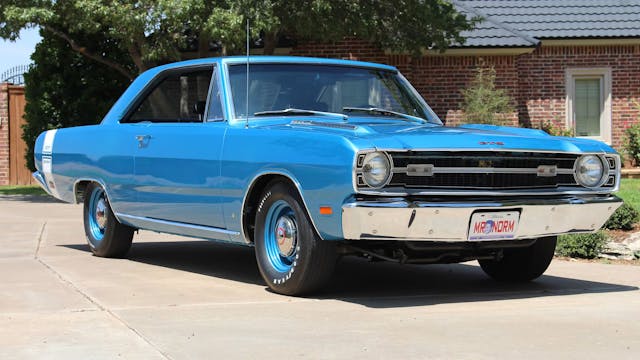
***
Check out the Hagerty Media homepage so you don’t miss a single story, or better yet, bookmark it. To get our best stories delivered right to your inbox, subscribe to our newsletters.

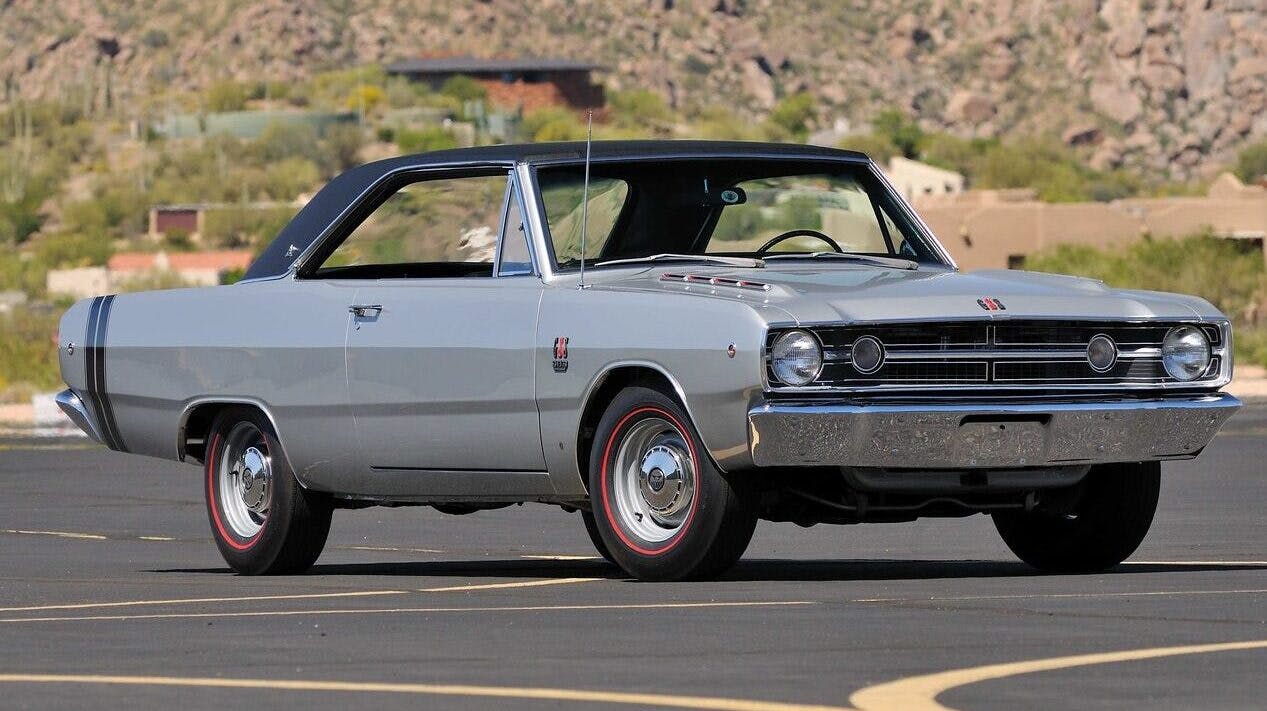
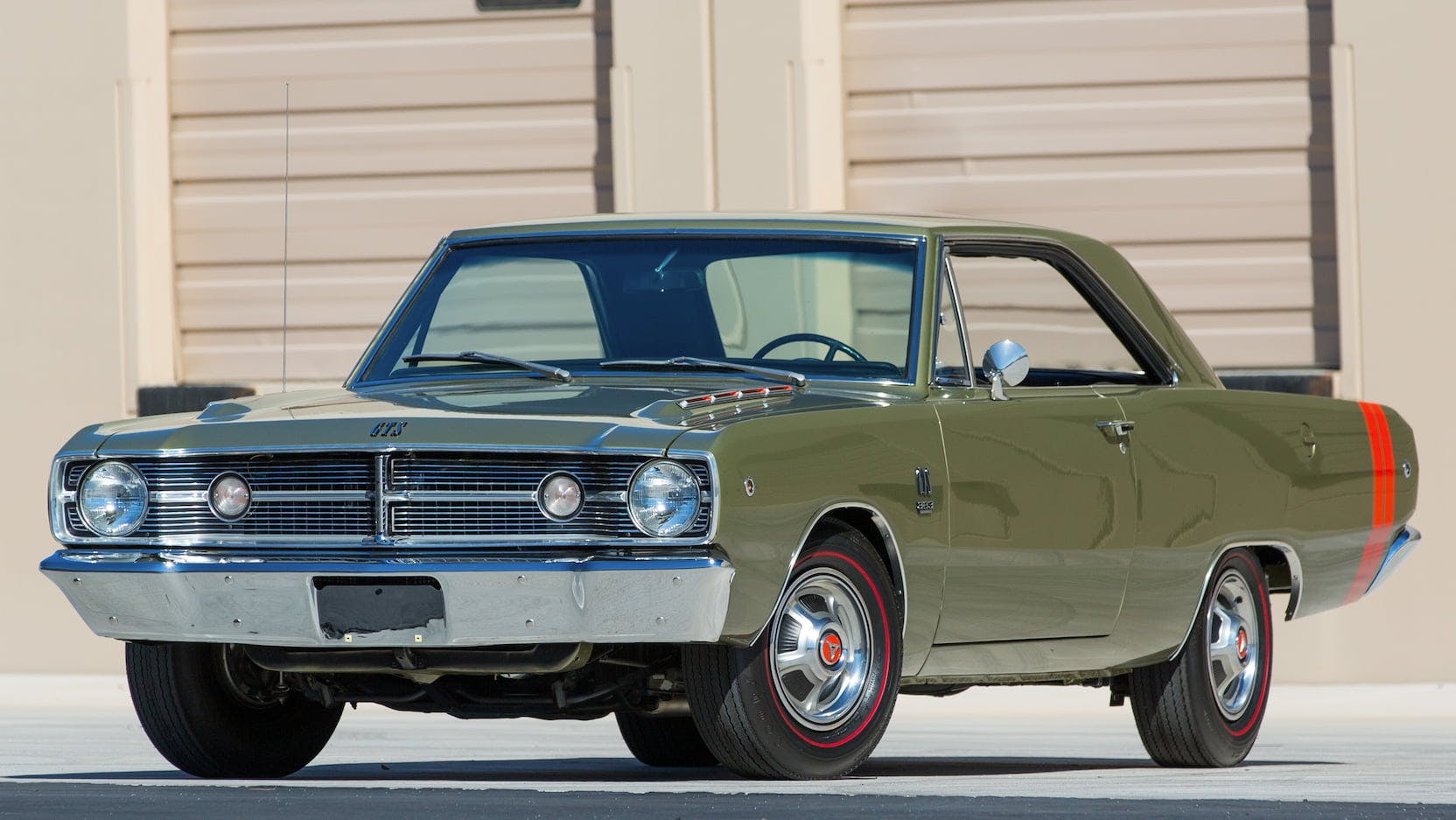
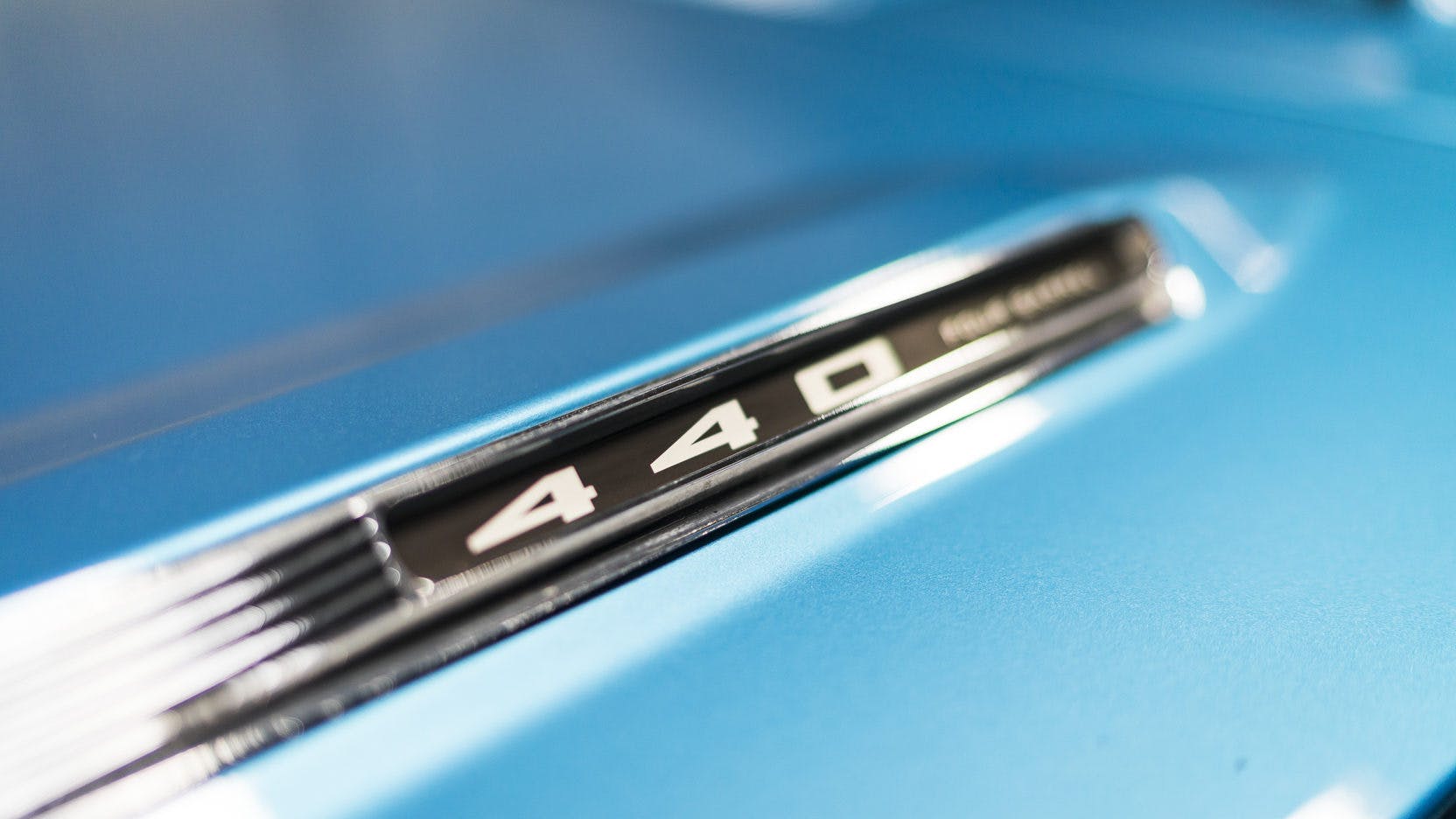
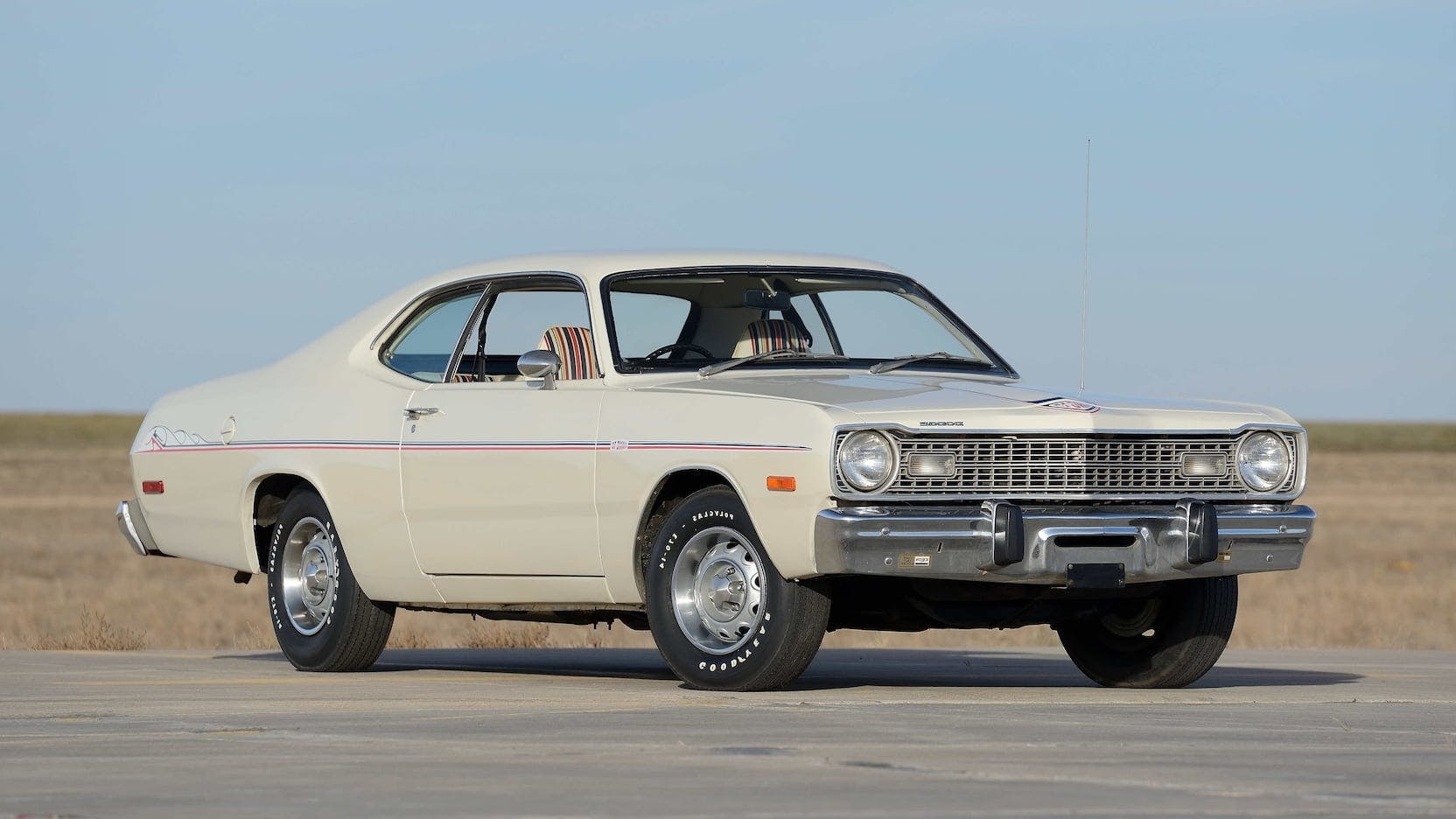
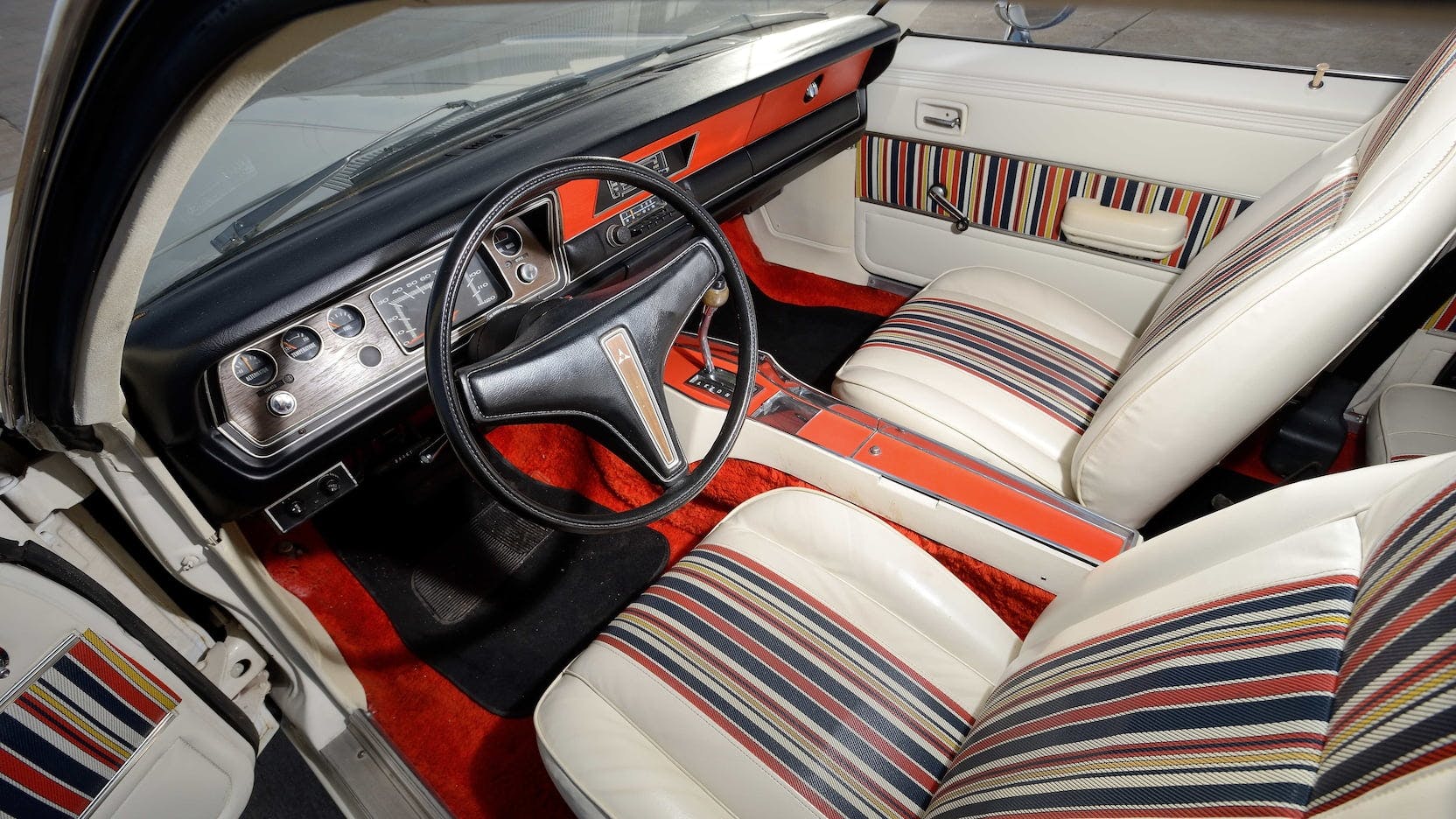


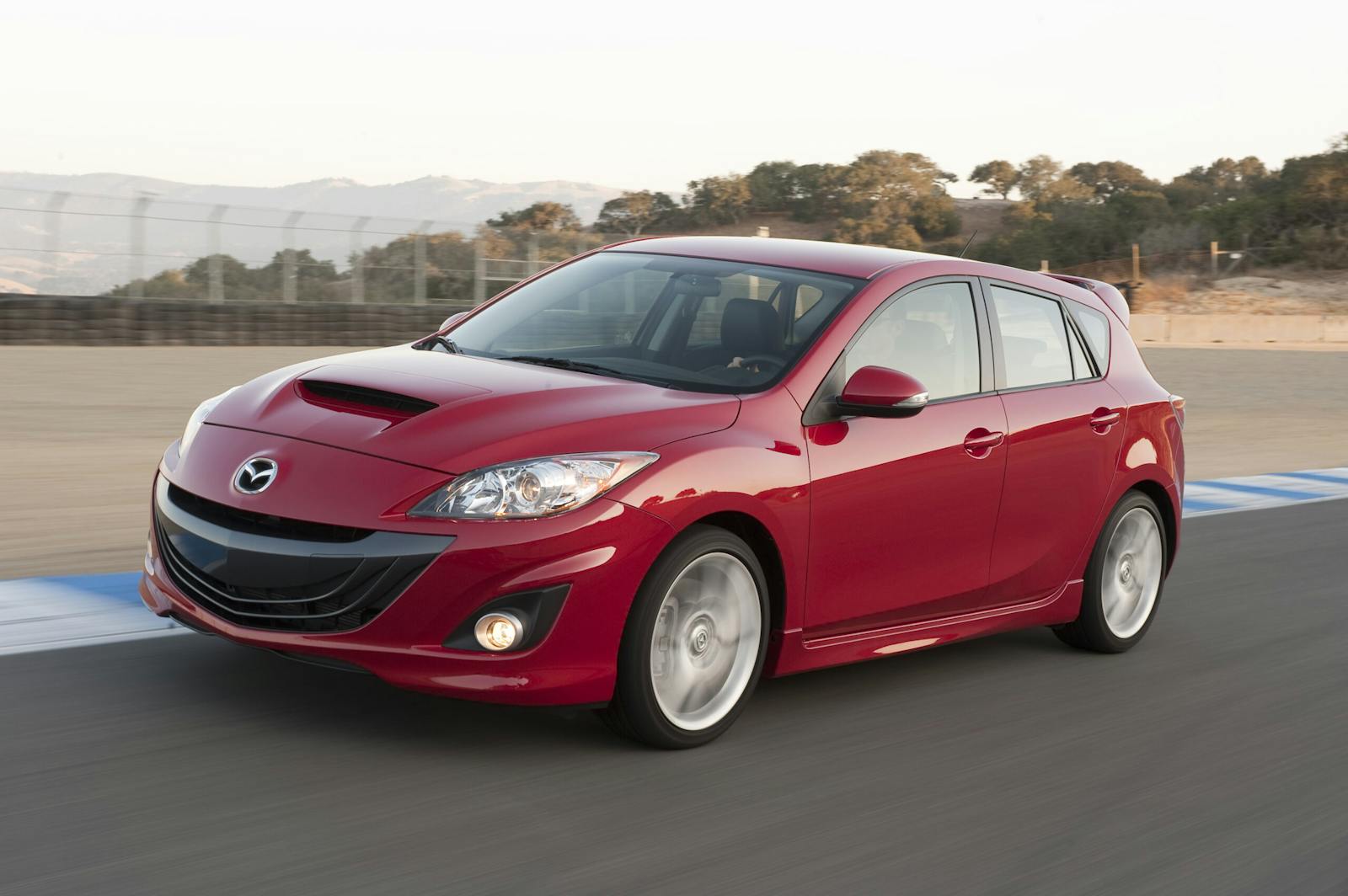
My second car in high school was a 1968 Dart. It was just a plain Jane white with blue interior, 225 slant six and automatic and no power anything but it was a fun car. The only weak point were the small drum brakes. I still remember going to school one day with four of my friends and getting to the bottom of a long hill only to find the brakes faded to nothing. as I remember the six cylinder cars had nine inch drums all around with like inch and a quarter wide shoes.
As my first company car I was given a slant six Dodge. in the first year I got into a proverbial chain of accidents.
Rear ended while waiting for a stop light to change – very cool Volvo coupe. Those cars are tough – tail lights halfway to the my back light. The moose in Maine? Landing in a swamp spoiled a suit and the front end. Within a month a car in front of me stopped for a traffic light blocking pedestrian passage. The driver saw a parked Cop car and backed up. Scratch 1 left fender, grill, bumper – et. al. Who would keep fixing that car? With a body, perhaps spending a year or more, rusting from the inside out in a field.
All of the accidents were in less than 2 years. I was invited to a service by the NJ State Police to learn what I was doing wrong, ( now driving a 67 Chevrolet. snapped the drive belt to the a/c. fixed it and was nearly late.
Aced the test. Proved my reflexes were much better than typical. Big NJ State Trooper asks if he can speak to me. (say what?) I gave him the story, leaving the moose event ’til last. He never raised a eye brow. He thanked me for my time. I was so stunned I had to say – I’m surprised you didn’t throw me out or lecture me.
Quietly, he said: ‘I brought my family down here to get a better paying job’.
Don’t forget the Plymouth version, the Scamp!
I always liked the Dart/Scamp body style (and did not especially like the Demon/Duster style), which was probably opposite of most people my age back in the 1970’s. I liked the two-door hardtop style and its crisp lines, and did not like the pop-out quarter windows of the Demon, which I thought were chintzy.
I did date a girl who had a Dart Sport 360, though; she was cute, but it was cooler, given its 360.
In 1975 I traded a Harley for a 69 GTS 340, 4 barrel, automatic. I had also just bought a new 75 Ford Elite so I was selling the GTS to my sister who needed a car. Our Dad took the Dodge for a test drive and told me that my sister couldn’t have because it was too fast for her. I sold it but regret I didn’t keep it.
In 68, my friends and I went to small-town, local Dodge dealer to look at new 340GTS. I didn’t like the color, but told the dealer I’d be interested in gold with black vinyl roof and black bumble bee stripes. Didn’t think about again, but a couple of months later, there it was — in the showroom! We went in to look and drool, but there was no way I could afford that car while I was in high school. Dealer said “he bought it just for me”. I said, sorry, no can do. IIRC, it sat there for quite a while before it finally sold. That’s one car I’d really like another shot at…
The engine and trans were good – body’s were rust buckets.
When I got married in ‘72 my father in law had a ‘71 Dart with a slant 6 automatic. It had air conditioning and he lent it to us for our honeymoon in Florida. We parked it on the beach and rented mopeds to run up down Coco beach. When we got back the tide was coming in and washing under the car. I fired it up and got to higher ground just in time. The locals all laughed at at me but said they were watching and would have yanked the car out if I had got stuck. I was all embarrassed because I never knew about the tide coming in.
I never told my father in law his car almost floated out to sea. My wife and I still laugh over that one.
I still wish that I had my old 69 Swinger 340 back. The original owner had a lot of success in stocks class at York back in the day. He beat 350 brand x cars regularly. On the street I could beat some of the big blocks. The car wore the light green frost color with a black vynl top and the white scat pack stripe. It had the regular black interior with the 4 speed and 3.23 gears.
I briefly had a ’72 Plymouth Scamp with a 318 2V and it was a very peppy little car. It would really light up the right rear tire off of a stop. My mother-in-law gave it to my son and he gave it to my daughter who didn’t want it either. This was a nice 2 dr. hardtop in white with a black vinyl roof and black interior (with 70’s black and white houndstooth inserts). I gave her my ’83 Bronco XLT and sold off the Scamp. A boy she went to high school with bought it for $1,700. He brought his grampa along to test drive the car and finance the purchase and I heard later that grampa parked it in his own garage. It was a sweet little ride.